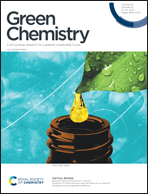Bimetallic copper/cobalt-cocatalyzed double aerobic phenol oxidation/cyclization toward π-extended benzofuro[2,3-b]indoles as electron donors for electroluminescence†
Abstract
Benzofuro[2,3-b]indoles, apart from their attractive biological features, constitute a novel family of electron donors for electroluminescent materials. Reported herein is the establishment of a strategy involving bimetallic catalysis to form such π-conjugated extended frameworks, specifically via the CoCl2/Cu(OTf)2-catalyzed double aerobic oxidative cycloaddition of indoles with p-hydroquinone ester. The crucial and distinct roles of the two metals salts and the alcohol solvent were clarified. This oxidation system enabled the disruption of the well-established acid-catalyzed quinone–indole [3 + 2] cycloaddition reaction favoring benzofuro[2,3-b]indolines and is superior to previously known multi-step synthetic methods involving Pd-catalyzed cross-coupling with pre-functionalized (pseudo)halides. Moreover, the photophysical properties of the product were preliminarily investigated, the results of which suggested the potential of these polycyclic heteroaromatics to be used in efficient deep-blue organic light-emitting diodes.
![Graphical abstract: Bimetallic copper/cobalt-cocatalyzed double aerobic phenol oxidation/cyclization toward π-extended benzofuro[2,3-b]indoles as electron donors for electroluminescence](/en/Image/Get?imageInfo.ImageType=GA&imageInfo.ImageIdentifier.ManuscriptID=D1GC01658J&imageInfo.ImageIdentifier.Year=2021)


 Please wait while we load your content...
Please wait while we load your content...